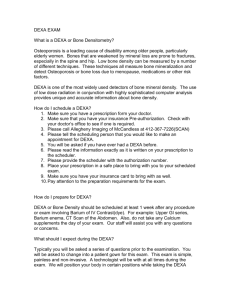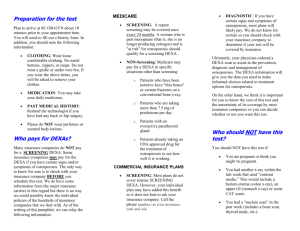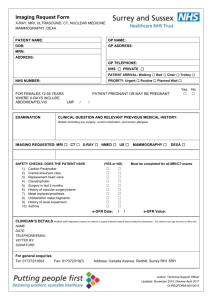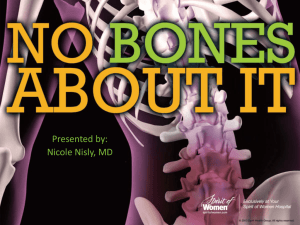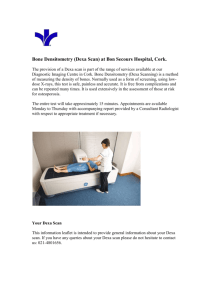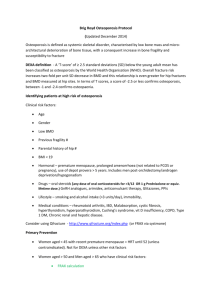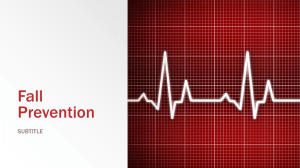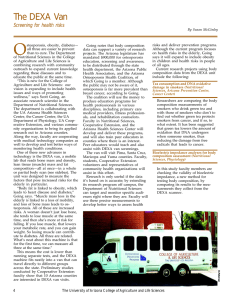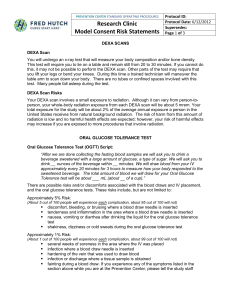Original Article
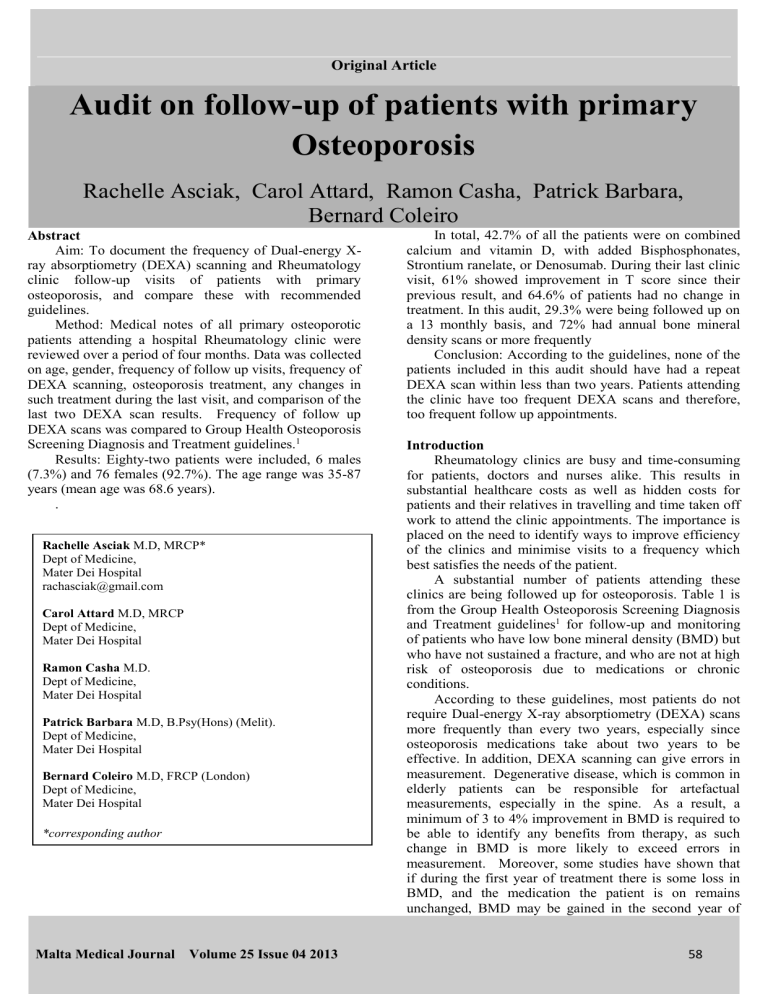
Original Article
Audit on follow-up of patients with primary
Osteoporosis
Rachelle Asciak, Carol Attard, Ramon Casha, Patrick Barbara,
Bernard Coleiro
Abstract
Aim: To document the frequency of Dual-energy Xray absorptiometry (DEXA) scanning and Rheumatology clinic follow-up visits of patients with primary osteoporosis, and compare these with recommended guidelines.
Method: Medical notes of all primary osteoporotic patients attending a hospital Rheumatology clinic were
In total, 42.7% of all the patients were on combined calcium and vitamin D, with added Bisphosphonates,
Strontium ranelate, or Denosumab. During their last clinic visit, 61% showed improvement in T score since their previous result, and 64.6% of patients had no change in treatment. In this audit, 29.3% were being followed up on a 13 monthly basis, and 72% had annual bone mineral density scans or more frequently reviewed over a period of four months. Data was collected on age, gender, frequency of follow up visits, frequency of
DEXA scanning, osteoporosis treatment, any changes in such treatment during the last visit, and comparison of the last two DEXA scan results. Frequency of follow up
DEXA scans was compared to Group Health Osteoporosis
Screening Diagnosis and Treatment guidelines.
1
*corresponding author
Conclusion: According to the guidelines, none of the patients included in this audit should have had a repeat
DEXA scan within less than two years. Patients attending the clinic have too frequent DEXA scans and therefore, too frequent follow up appointments.
Introduction
Rheumatology clinics are busy and time-consuming for patients, doctors and nurses alike. This results in substantial healthcare costs as well as hidden costs for
Results: Eighty-two patients were included, 6 males
(7.3%) and 76 females (92.7%). The age range was 35-87 years (mean age was 68.6 years).
.
Rachelle Asciak M.D, MRCP*
Dept of Medicine,
Mater Dei Hospital rachasciak@gmail.com
Carol Attard M.D, MRCP
Dept of Medicine, patients and their relatives in travelling and time taken off work to attend the clinic appointments. The importance is placed on the need to identify ways to improve efficiency of the clinics and minimise visits to a frequency which best satisfies the needs of the patient.
A substantial number of patients attending these clinics are being followed up for osteoporosis. Table 1 is from the Group Health Osteoporosis Screening Diagnosis and Treatment guidelines 1 for follow-up and monitoring of patients who have low bone mineral density (BMD) but who have not sustained a fracture, and who are not at high
Mater Dei Hospital
Ramon Casha M.D.
Dept of Medicine,
Mater Dei Hospital
Patrick Barbara M.D, B.Psy(Hons) (Melit).
Dept of Medicine,
Mater Dei Hospital
Bernard Coleiro M.D, FRCP (London)
Dept of Medicine, risk of osteoporosis due to medications or chronic conditions.
According to these guidelines, most patients do not require Dual-energy X-ray absorptiometry (DEXA) scans more frequently than every two years, especially since osteoporosis medications take about two years to be effective. In addition, DEXA scanning can give errors in measurement. Degenerative disease, which is common in
Mater Dei Hospital elderly patients can be responsible for artefactual measurements, especially in the spine. As a result, a minimum of 3 to 4% improvement in BMD is required to be able to identify any benefits from therapy, as such change in BMD is more likely to exceed errors in measurement. Moreover, some studies have shown that if during the first year of treatment there is some loss in
BMD, and the medication the patient is on remains unchanged, BMD may be gained in the second year of
Malta Medical Journal Volume 25 Issue 04 2013 58
Original Article
treatment. This means that even if there is some loss of patients (25.7%) were not compliant to the
BMD during the initial period of treatment, medications should not be changed on the basis of such results. Therefore, there is no point in repeating a DEXA scan before two years 2 .
Aim
The aim of this audit was to document the frequency of DEXA scanning and Rheumatology clinic follow-up visits of patients with primary osteoporosis, and compare these with recommended guidelines, in order to identify ways in which to improve efficiency of Rheumatology clinics.
Method
Consent was obtained from the Mater Dei Hospital’s
Data Protection Officer to access the medical notes of all primary osteoporotic patients attending a hospital rheumatology clinic of one of the rheumatology consultants. The medical notes were reviewed and patients with predisposing factors for secondary osteoporosis, including patients on long term steroid treatment, were excluded, as were patients with osteopenia.
Over a period of four months, data was collected on age, gender, frequency of follow up visits, frequency of
DEXA scanning, osteoporosis treatment at last visit, any changes in such treatment during the last visit, and comparison of the last two DEXA scan results. In this audit, any improvement in T score, even slight, and in either hip or spine, was classified as an improvement in T score, and any deterioration in T score or same T score when comparing the last two DEXA scans was classified as no improvement in T score.
Data was collected and analysed using Microsoft
Excel®.
Frequency of follow up DEXA scans was compared to Group Health Osteoporosis Screening Diagnosis and
Treatment guidelines.
1
Results
A total of 82 patients were included in this audit, and one patient had passed away in the period between the last clinic visit and the data collection period. There were 6 males (7.3%) and 76 females (92.7%). The age range was
35-87 years (average age excluding the patient who had passed away was 68.6 years; median age: 73 years, mode:
73 years).
History of a fracture was documented in the notes in
15 patients (18.3%), however it was not always clarified whether this was a fragility fracture or secondary to trauma.
Treatment
Bisphosphonates, Strontium ranelate, or Denosumab. On the other hand, 28.1% of patients were on calcium and vitamin D supplements only, and 15.9% were on
Bisphosphonates, Strontium ranelate or Denosumab only.
The remaining 2.4% of patients were on no treatment
(Table 2 and Figure 1).
Changes in Treatment during the last clinic visit
In this audit, 48 patients (58.5%) had no change in osteoporosis treatment during their last clinic visit. Of these, 10 had a DEXA scan done at 24 months or less frequently, while 38 (79.1%) had had a repeat DEXA scan within less than 24 months. Twenty-seven of these 38 patients (71.0%) showed improvement in their T-score, while the remaining 11 patients (28.9%) showed no improvement in T-score and yet there was no treatment change during their last visit when reviewed with the
DEXA scan result. Therefore, 38 patients had a DEXA scan done too early, and irrespective of whether there was deterioration in the T score or not, there was no change in treatment during the last visit.
There were 18 patients (22.0%) who had a change in their osteoporosis treatment, and of these, 11 (61.1%) showed no improvement in T score, which may have triggered the treatment change. In the remaining 7 patients
(38.9%) who had shown improvement in T score, the reason for the osteoporosis treatment change was not identified. This could have been related to patients’ preferences or side-effects which were not documented.
In a further 6.1%, osteoporosis treatment was documented to have been changed due to side-effects to the medication. In 60.0% of patients, no change in any medical treatment, including treatment for osteoporosis or for unrelated conditions, was made during their last follow-up visit. In 4.9%, compliance with osteoporosis medication was advised and documented in the medical notes. In 3.7% of patients, treatment change was advised but the patient decided not to go for the new treatment because of cost burden (Table 3 and Figure 2).
Improvement when comparing last two DEXA scan results
During the last visit, 61% of patients showed improvement in T score from the previous DEXA scan result documented in the medical notes. On the other hand, 30 patients (36.6%) did not show an improvement in T score, and in 2.4% it was not possible to make a comparison between the last two DEXA scan results because the results were both unavailable in the notes
(Table 4 and Figure 3). Of the 30 patients with no improvement in T score, 17 (56.7%) received advice and had their osteoporosis treatment changed or adjusted during their last clinic visit. The other 13 patients (43.3%) showed no improvement in T score, however did not
There were 35 patients (42.7%) on combined calcium and vitamin D supplements with added Bisphosphonates,
Strontium ranelate, or Denosumab. Nine of these 35 receive any treatment change and advice was not documented to have been given.
Malta Medical Journal Volume 25 Issue 04 2013 59
Original Article
Treatment:
Table 2: shows the osteoporosis treatment that patients were on during their last visit to the hospital Rheumatology clinic.
Bisphos = Bisphosphonates; Strontium = Strontium ranelate
Current treatment
None
Calcium and Vitamin D supplements only
Bisphos/Strontium/Denosumab
Combined Calcium and
Vitamin D, with
Bisphos/Strontium/Denosumab
Prescribed combined Calcium and Vitamin D, with
Bisphos/Strontium/Denosumab but patient not compliant to treatment
Number of patients
2
23
13
35
9
Percentage
2.4
28.1
15.9
42.7
11.0
Figure 1: shows the osteoporosis treatment that patients were on during their last visit to the hospital Rheumatology clinic.
Vit D = Vitamin D; Bisphos = Bisphosphonate ; Strontium = Strontium ranelate
Osteoporosis treatment at last clinic visit
23
35
Number of patients
13
2
None
9
Calcium and Vit D only Bisphos/Strontium/Denosumab Combined Calcium and Vit D, with
Prescribed combined Calcium and Vit D, with
Bisphos/Strontium/Denosumab Bisphos/Strontium/Denosumab but patient not compliant
Malta Medical Journal Volume 25 Issue 04 2013 60
Original Article
Changes in Treatment during the last clinic visit:
Table 3: shows the number and percentage of patients with changes in osteoporosis treatment made during the last rheumatology clinic follow up visit.
Changes in Treatment
Osteoporosis treatment change
No change in any treatment
No osteoporosis treatment change, but compliance with medication advised
Treatment change considered but patients refused in view of cost burden
Osteoporosis treatment was changed due to medication side effects
Treatment change during last clinic visit was unrelated to osteoporosis medication
Number of patients
18
49
4
3
5
3
Percentage of patients
22.0
60.0
4.9
3.7
6.1
3.7
Figure 2: shows the number of patients with changes in osteoporosis treatment made during the last rheumatology clinic follow up visit.
Treatment change during last visit
49 Number of patients
18
4 3
5
3
Osteoporosis
Treatment change
No change No osteoporosis treatment change but
Treatment change considered but compliance with medication advised patient could not afford to buy the new medication
Treatment change due to SE
Treatment change unrelated to osteoporosis medication eg thyroxine dose increase
Malta Medical Journal Volume 25 Issue 04 2013 61
Original Article
Improvement when comparing last two DEXA scan results:
Table 4: shows the improvement in T score when comparing the last 2 DEXA scan results
Improvement in T score Number of patients Percentage
Yes 50 61.0
No
Unable to make comparison as only 1 DEXA result in file
30
2
36.6
2.4
Figure 3: shows the improvement in T score when comparing the last 2 DEXA scan results
Improvement in T score between the last 2
DEXA results
50
Number of patients
30
2
Yes No Unable to make comparison as only 1 DEXA result in file
There are two bone densitometers at Mater Dei hospital, but the machine used for patients’ bone density scan was not specified in the medical notes.
Compliance
There were 9 patients who were on combined calcium and vitamin D supplements with added
Bisphosphonates, Strontium ranelate, or Denosumab, and documented to be non-compliant with treatment. Of these,
6 (66.7%) showed no improvement in T score, and all of these had clinic visits scheduled more frequently than 24 monthly, and there were 4 (44.4%) who had repeat DEXA scan more frequently than 24 monthly.
Frequency of follow up visits
Follow up visits to the clinic were 13 monthly in
29.3% of patients, while 52.5% were being followed up every 12 months or more frequently (follow-up visit after
12 months - 24.4%, 11 months – 15.9%, 10 months –
3.7%, 8 months - 1.2%, 7 months - 2.4, 6 months -
3.7%, 2 months - 1.2%). 1 patient (1.2%) was followed up after 1 month because of a deranged blood result unrelated to osteoporosis. Eleven percent of patients were followed up after 14 months, and 1.2% of patients were followed up after 15, 18, 19, 23 and 24 months each (Table 5 and
Figure 4).
Frequency of DEXA scans
DEXA scan was repeated after 12 months in 65.9% of patients, while 6.1% of patients had more frequent
DEXA scans (4.9% 11 months, and 1.2% 10 months). In this audit, 1.2% had a repeat DEXA scan after 13, 15, 18 and 36 months each, while 15.9% had a repeat DEXA scan after 2 years. In 7.3% of patients it was not possible to determine the frequency of DEXA scans because there was only a single DEXA scan result available in the notes
(Table 6 and Figure 5).
Malta Medical Journal Volume 25 Issue 04 2013 62
Original Article
Frequency of follow up visits:
Table 5: shows the number and percentage of patients and their frequency of follow up visits in months. NB: the patient followed up after 1 month was given such an early follow up appointment because of deranged results not related to osteoporosis.
Frequency of follow up visits in number of months
1
2
Number of patients
1
1
Percentage
1.2
1.2
13
14
15
18
19
23
24
6
7
8
10
11
12
24
9
1
1
1
1
1
3
2
1
3
13
20
29.3
11.0
1.2
1.2
1.2
1.2
1.2
3.7
2.4
1.2
3.7
15.9
24.4
Figure 4: shows the percentage of patients and their frequency of follow up visits in months
Frequency of follow up visits
1.2
1.2
1 2
3.7
6
2.4
1.2
3.7
15.9
24.4
29.3
11
Percentage of patients
1.2
1.2
1.2
1.2
1.2
7 8 10 11 12 13 14 15 18 19
Frequency of follow up visits in number of months
23 24
Malta Medical Journal Volume 25 Issue 04 2013 63
Original Article
Frequency of DEXA scans:
Table 6: shows the number and percentage of patients and the period of time between their last 2 DEXA scans. In 6 cases, there was only one available DEXA scan result in the notes, and so it was not possible to determine the frequency of DEXA scans.
Number of months
10
Number of patients
1
Percentage
1.2
11
12
13
15
18
24
36
Unknown
4
54
1
1
1
13
1
6
4.9
65.9
1.2
1.2
1.2
15.9
1.2
7.3
Figure 5: shows the percentage of patients and their frequency of DEXA scans (number of months between the last two
DEXA scans.
Frequency of DEXA scans
65.9% percentage of patients
15.9%
1.2%
4.9%
1.2% 1.2% 1.2% 1.2%
10 11 12 13 15 18
Number of months
24 36
Malta Medical Journal Volume 25 Issue 04 2013
7.3%
Unknown
64
Original Article
The relationship between frequency of outpatient visits scan results may have led to inaccurate data. and frequency of DEXA scanning
It was noted that in 16 patients (19.5%) there was a discrepancy between the DEXA scan frequency and the frequency of their follow-up appointments. Six of these patients (37.5%) had missed their DEXA scan appointment, or had not brought the DEXA scan result to the clinic visit. Seven patients (43.8%) were seen earlier then the next scheduled DEXA scan because of medical reasons, unrelated to osteoporosis. No reason for an earlier clinic visit was identified in two patients (12.5%). One patient (6.25%) had brought two past DEXA scan results, which were two years apart, to a new case appointment at the clinic. This same patient was then given a one-yearly follow-up appointment.
Discussion and Conclusions
The majority of patients suffering from primary osteoporosis are female, with a mean age of 68.6 years.
As documented in the last follow up visit, most patients
(42.7%) being followed up were on combined calcium and vitamin D supplements together with a bisphosphonate, Strontium ranelate or Denosumab. When keeping in mind that the patients included in this audit were all being followed up at a hospital Rheumatology clinic, this raises the question of whether the rest (57.3%) of the patients, the majority of which were not even on bone anti-resorptive treatment, may be followed up by their GP and referred only if complications arise. This is further emphasised by the fact that only in 21.9% of patients was there a change in osteoporosis treatment during their last follow up visit. For the 6.1% in whom osteoporosis treatment was changed due to side-effects to the osteoporosis medication, waiting for the next followup clinic visit is unnecessary since a help-line is available to address such issues.
It is reassuring that in the majority of patients
(61.0%), an improvement in DEXA was noted during the last visit, when compared with the previous visit’s result.
However, for the purpose of this audit, any amelioration in T score, however slight, was documented as improvement. This means that where there was deterioration in T score of the spine, but a larger improvement in T score of the hip, and vice versa, this patient was classified as having an overall improved
BMD. Unfortunately, in view of poor documentation in the patients’ notes and also the lack of official DEXA scan results available in the notes or on the hospital online system, where T score “hip” was documented, it was impossible to tell if this referred to the T score of the neck of femur or the total T score. It was also not possible to tell whether the same bone densitometer was used when comparing DEXA scan results, so it was not possible to exclude patients who had had different bone densitometers used. As a result, comparison of DEXA
Of the 30 patients with no improvement in T-score,
17 (56.7%) received advice and had their osteoporosis treatment changed or adjusted during their last clinic visit.
The other 13 patients (43.3%) did not receive any treatment change and advice was not documented to have been given. This raises the question of whether this clinic visit could have been avoided.
According to Osteoporosis Screening, Diagnosis and
Treatment Guideline by Group Health, patients who have never sustained a fracture, with a T score of -2.5 or less and taking no treatment, DEXA scans should be done every 2 years or less frequently (Table 1). For patients who are taking Bisphosphonates, DEXA scans can be repeated every 5 years. For patients who have sustained fractures, DEXA scans should be done 2-3 years after starting treatment. This is because medications are effective only 2 years after they have been started, and therefore fractures occurring during the first two years of treatment are unlikely to represent treatment failure.
1
Given the fact that according to the guidelines, none of the patients included in this audit should have had a repeat
DEXA scan within less than two years, it is important to note that 72% of patients whose notes were reviewed had
12 monthly DEXA scans or more. The patients then had a follow up appointment at the clinic to review the result and this led to increased unnecessary visits to the clinic, with most patients having an eleven to fourteen monthly follow up visit. This is further emphasised by the fact that most patients (64.6%) had no change in osteoporosis treatment during their last visit at the clinic.
A review of published research on strategies and processes involving primary care that influence the efficiency and effectiveness of outpatient services showed that discharging patients to primary care follow up results in improved access and reduced outpatient attendance, without adverse effects on the quality of care. This leads to overall reduced NHS costs, despite increased primary care workload. This however would require primary care physicians to be able to request and have access to the results of hospital based investigations.
4
Limitations
Fractures had been documented in the patient notes in
18.3%, but it was not specified whether these were fragility fractures or not. Nonetheless, in many patients there was no documentation of whether the patient had had any past history of fractures or not.
There are two bone densitometers at Mater Dei hospital.
Before any change in T-score is analysed and acted upon, it should be ascertained that the same bone densitometer is used for the patient’s bone mineral density scan. In this audit it was not possible to assess whether this is being done during the clinic because the machine used for patients’ bone density scan was not s pecified in the medical notes.
Malta Medical Journal Volume 25 Issue 04 2013 65
Original Article
This audit highlights poor documentation of DEXA scan results and raises the concern that DEXA scan results
Suggestions
DEXA scan results should be uploaded with the are not available on the hospital online results system, meaning that results are often lost, or kept by the patient without a copy in the file, making quick access to results impossible. rest of radiological studies on PACs, making them readily available for all doctors caring for the patient, who need to access them and compare to previous results.
Table 1: Group Health Osteoporosis Screening Diagnosis and Treatment guidelines
1
for follow-up and monitoring of patients who have low bone density.
DEXA = Dual-energy X-ray absorptiometry scan
Baseline or most recent DEXA T score and/or clinical circumstances
Higher than -1.5
-1.5 to -1.9
-2.0 to -2.4
-2.5 or lower, choosing no treatment
-2.5 or lower, choosing bisphosphonates
Patients on chronic steroids
Recommended screening interval
Repeat DEXA scan only if the number of risk factors increases or there is a clinical concern regarding osteoporosis
May choose to repeat DEXA scan in 5 years
May choose to repeat DEXA in 2 years
Repeat DEXA scan as clinically indicated but no more frequently than every 2 years
May choose to repeat DEXA scan in 5 years
Patients at high risk due to comorbid conditions, and patients with fractures
Burden on the rheumatology clinics can be lessened significantly if stable, mild, and uncomplicated cases of primary osteoporosis are followed up by their GP, and referred only if any deterioration or complications arise.
This may be achieved by means of referral guidelines for primary care physicians. The load on the clinics can be further reduced, together with the patients’ radiationexposure, by following the latest guidelines on frequency of DEXA scanning and follow-up.
The World Health Organisation (WHO) fracture risk assessment (FRAX) score was not documented in the medical notes of any of the patients seen for osteoporosis.
The FRAX tool is used to identify the ten year probability of fracture, and the aim of osteoporotic treatment is ultimately to reduce this risk. The setting up of specific osteoporosis clinics may allow more time and attention to be dedicated to calculating and documenting the FRAX score at every visit. This could be more beneficial as a guide to patient improvement or deterioration than the T score in isolation.
Repeat the DEXA scan 6 months after the initiation of corticosteroid treatment and annually thereafter (expert opinion)
Repeat DEXA scan after 2–3 years of treatment
Unfortunately, it is not known whether using either
FRAX or QFracture risk assessment tools can reliably estimate the risk of fractures in treated osteoporotic patients as in untreated patients. Further studies are required with regards to this issue 5 .
References
1.
Osteoporosis Screening, Diagnosis, and Treatment Guideline,
Group Health Cooperative, 2011.
2.
Scottish Intercollegiate Guidelines Network. Management of osteoporosis. Guideline No 71. June 2003 updated April 2004.
ISBN 1899893 73 3.
3.
Blake GM, Fogelman I. The Role of DXA bone density scans in the diagnosis and treatment of osteoporosis. Postgrad Med
Journal 2007, August;83(982):509-517 doi:
10.1136/pgmj.2007.057505 PMCID:PMC2600106.
4.
Roland M, McDonald R, Sibbald B, National Primary Care
Research and development centre, University of Manchester.
Outpatient services and primary care: a scoping review of research into strategies for improving outpatient effectiveness and efficiency.
National Institute for Health Research (NIHR)
May 2006.
5.
National Institute for Health and Clinical Excellence guideline on
Osteoporosis: assessing the risk of fragility fracture. August 20 12.
Malta Medical Journal Volume 25 Issue 04 2013 66
